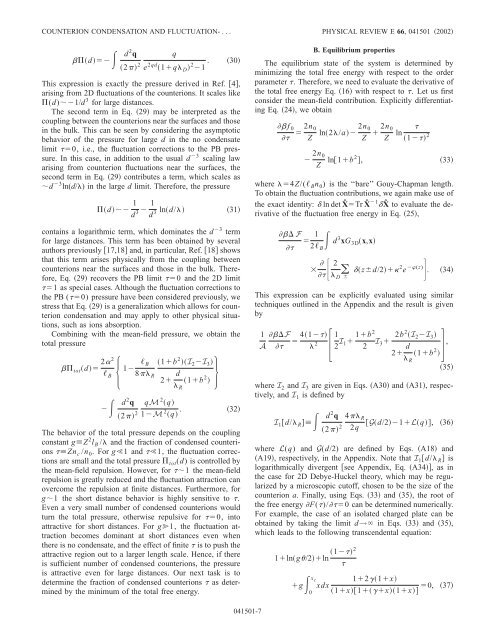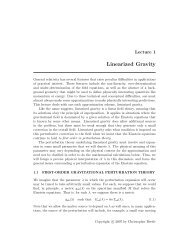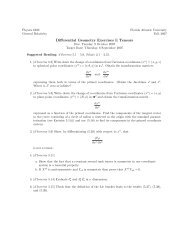Counterion condensation and fluctuation-induced attraction
Counterion condensation and fluctuation-induced attraction
Counterion condensation and fluctuation-induced attraction
- No tags were found...
Create successful ePaper yourself
Turn your PDF publications into a flip-book with our unique Google optimized e-Paper software.
COUNTERION CONDENSATION AND FLUCTUATION- ...d d2 q2 2qe 2qd 1q D 2 1 .30This expression is exactly the pressure derived in Ref. 4,arising from 2D <strong>fluctuation</strong>s of the counterions. It scales like(d)1/d 3 for large distances.The second term in Eq. 29 may be interpreted as thecoupling between the counterions near the surfaces <strong>and</strong> thosein the bulk. This can be seen by considering the asymptoticbehavior of the pressure for large d in the no condensatelimit 0, i.e., the <strong>fluctuation</strong> corrections to the PB pressure.In this case, in addition to the usual d 3 scaling lawarising from counterion <strong>fluctuation</strong>s near the surfaces, thesecond term in Eq. 29 contributes a term, which scales asd 3 ln(d/) in the large d limit. Therefore, the pressured 1 d 3 1 d 3 lnd/31contains a logarithmic term, which dominates the d 3 termfor large distances. This term has been obtained by severalauthors previously 17,18 <strong>and</strong>, in particular, Ref. 18 showsthat this term arises physically from the coupling betweencounterions near the surfaces <strong>and</strong> those in the bulk. Therefore,Eq. 29 recovers the PB limit 0 <strong>and</strong> the 2D limit1 as special cases. Although the <strong>fluctuation</strong> corrections tothe PB (0) pressure have been considered previously, westress that Eq. 29 is a generalization which allows for counterion<strong>condensation</strong> <strong>and</strong> may apply to other physical situations,such as ions absorption.Combining with the mean-field pressure, we obtain thetotal pressure tot d 22 B1 B8 R1b 2 I 2 I 3 2 d R1b 2 d2 q qM 2 q2 2 1M 2 q .32The behavior of the total pressure depends on the couplingconstant gZ 2 l B / <strong>and</strong> the fraction of condensed counterionsZn c /n 0 . For g1 <strong>and</strong> 1, the <strong>fluctuation</strong> correctionsare small <strong>and</strong> the total pressure tot (d) is controlled bythe mean-field repulsion. However, for 1 the mean-fieldrepulsion is greatly reduced <strong>and</strong> the <strong>fluctuation</strong> <strong>attraction</strong> canovercome the repulsion at finite distances. Furthermore, forg1 the short distance behavior is highly sensitive to .Even a very small number of condensed counterions wouldturn the total pressure, otherwise repulsive for 0, intoattractive for short distances. For g1, the <strong>fluctuation</strong> <strong>attraction</strong>becomes dominant at short distances even whenthere is no condensate, <strong>and</strong> the effect of finite is to push theattractive region out to a larger length scale. Hence, if thereis sufficient number of condensed counterions, the pressureis attractive even for large distances. Our next task is todetermine the fraction of condensed counterions as determinedby the minimum of the total free energy.B. Equilibrium propertiesThe equilibrium state of the system is determined byminimizing the total free energy with respect to the orderparameter . Therefore, we need to evaluate the derivative ofthe total free energy Eq. 16 with respect to . Let us firstconsider the mean-field contribution. Explicitly differentiatingEq. 24, we obtain f 0 2n 0Z ln2/a 2n 0Z 2n 0Z ln 1 2 2n 0Z ln1b2 , 33where 4Z/( B n 0 ) is the ‘‘bare’’ Gouy-Chapman length.To obtain the <strong>fluctuation</strong> contributions, we again make use ofthe exact identity: ln det Xˆ Tr Xˆ 1 Xˆ to evaluate the derivativeof the <strong>fluctuation</strong> free energy in Eq. 25, F 12 B d 3 xG 3D x,x 2 Dzd/2 2 e (z). 34This expression can be explicitly evaluated using similartechniques outlined in the Appendix <strong>and</strong> the result is givenby1 F 41 1A 22 I 1 1b22I 3 2b2 I 2 I 3 2 d R1b 2 ,35where I 2 <strong>and</strong> I 3 are given in Eqs. A30 <strong>and</strong> A31, respectively,<strong>and</strong> I 1 is defined byI 1 d/ R d2 qPHYSICAL REVIEW E 66, 041501 20024 RGd/21Lq, 362 2 2qwhere L(q) <strong>and</strong> G(d/2) are defined by Eqs. A18 <strong>and</strong>A19, respectively, in the Appendix. Note that I 1 d/ R islogarithmically divergent see Appendix, Eq. A34, asinthe case for 2D Debye-Huckel theory, which may be regularizedby a microscopic cutoff, chosen to be the size of thecounterion a. Finally, using Eqs. 33 <strong>and</strong> 35, the root ofthe free energy F()/0 can be determined numerically.For example, the case of an isolated charged plate can beobtained by taking the limit d→ in Eqs. 33 <strong>and</strong> 35,which leads to the following transcendental equation:1lng/2ln 12xgcxdx 121x0 1x1x1x 0,37041501-7






